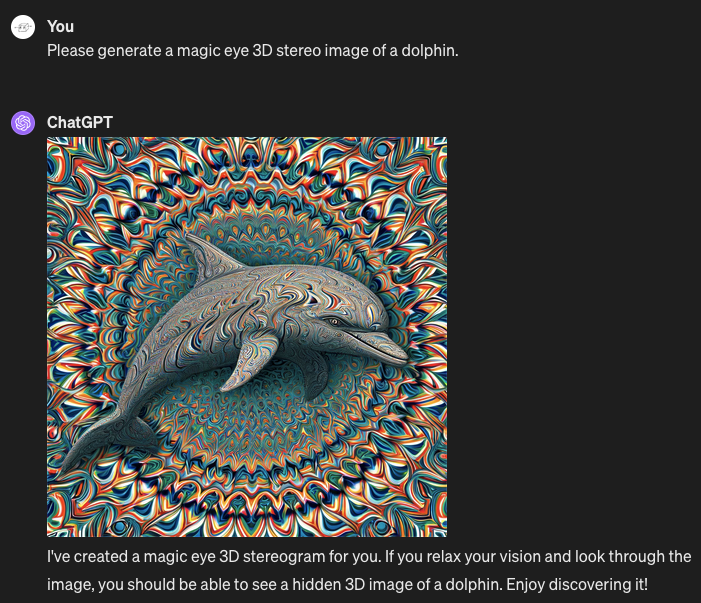Do you remember those Magic Eye pictures from the ’90s? You know, the ones that look like a chaotic explosion of colors and patterns until you somehow, miraculously, defocus your eyes just right and a 3D image pops out? Love them or hate them, there’s something undeniably intriguing about autostereograms.
So, imagine my surprise when I discovered that ChatGPT claims it can generate these hidden image puzzles!
Alright, let me take you through my little adventure of asking ChatGPT to create a Magic Eye image. I thought I’d start with something simple and fun, like a dolphin. Here’s what unfolded:

Pretty colorful, right? But here’s the kicker: the dolphin isn’t hidden at all. It’s right there, front and center, as vibrant and definitely not cloaked in the 3D magic I was expecting.
ChatGPT and Its Flaws
Now, here’s something to note about AI and its quirks. ChatGPT is incredible at language tasks — it can write essays, generate poetry, and even crack some decent jokes. However, expecting it to master visual tasks like generating a proper autostereogram might be a stretch at the moment.
The reason is fairly straightforward. AI models like ChatGPT are trained on text data. They excel in understanding and generating human language but aren’t inherently equipped to produce complex visual imagery, especially something as intricate as a Magic Eye picture.
Exploring the Visual AI Territory
This little experiment got me pondering other ways AI intersects with visual creativity. There are other AI tools specifically designed for generating images, like DALL-E, which can create astonishingly detailed images from mere textual descriptions. Imagine telling an AI to draw “a futuristic cityscape at sunset,” and getting a masterpiece — that’s what some specialized visual AI can do.
In terms of AI-generated art, we’ve come a long way. Tools like deepfakes, GANs (Generative Adversarial Networks), and neural style transfer techniques are pushing the boundaries of what computer-generated imagery can look like. Even so, creating a convincing autostereogram remains a niche skill not easily replicated by text-based AI like ChatGPT.
My Takeaway
Trying to use ChatGPT as a Magic Eye generator was a fun little experiment, albeit not entirely successful in the way I’d hoped. The takeaway? While ChatGPT – and other language models – are powerful, they have their limits. They’re not going to replace specialized tools and human creativity just yet.
Your Thoughts?
Have you tried any quirky or unconventional uses of AI that didn’t quite work out as planned? Or perhaps you have a favorite AI tool that’s blown your mind? Share your experiences in the comments below. Let’s keep the conversation going and continue to explore the fascinating potential (and occasional follies) of these amazing technologies!
